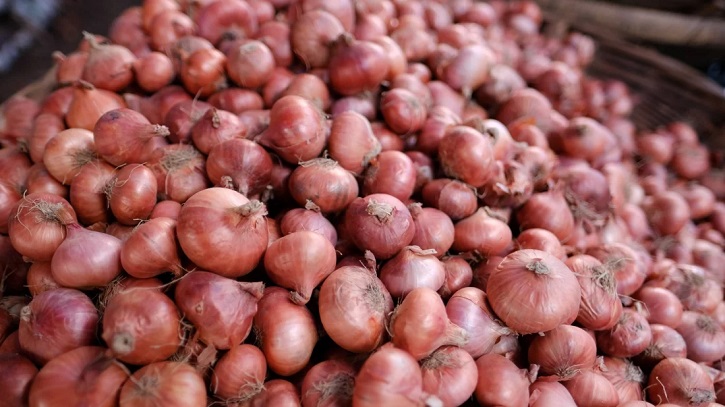
Price of the newly harvested onion has declined significantly after the farmers and traders had secured higher prices of the essential spice item in the country throughout the year in 2024.
Some farmers have though blamed imports of onion and syndicates for the price fall, ground reality shows that onion cultivation increased by around 30% this year, thanks to the price incentive last year.
The farmers in onion growing districts have been harvesting and selling early variety onion called “Murikata Peyaj”, grown not directly from seeds but from small size onion called “Guti” produced the previous year.
Because of higher price of “Guti”, production cost of the early variety onion surged but price of the produce also fell due to the supply glut, according to the farmers and local traders.
The growers usually use smaller portions of their land for producing early variety onion expecting a better price in times of supply shortfall between December and February, before major portions of their onion produced from seeds and saplings are harvested in the later months.
A high price of agricultural produces in one year is followed by a low price the next year and vice versa is defined by the economists as cobweb cycle. Such trend is being noticed in the onion cultivation and price last year and this year.
In Rajbari, farmers were selling each maund (40 kilograms) of newly harvested onion for Tk1,600 on average in the first week of January 2025, compared to Tk3,500 price for the same quantity last year.
“We’re making losses by producing early variety onion this year not only because of price fall but also because of the fact that we had to spend more than double, Tk9,000 or so, for buying each maund of small-size onion as seed this season,” Rubel Bepari, a 35-year-old farmer of Kantonagar, Rajbari Sadar, said.
He blamed a syndicate for the price fall but could not detail how and what kind of cartel works in the onion market.
He admitted that he cultivated onion on more than two acres of land this year as against 1.5 acres last year and that he got slightly better price a month ago.
According to Kamrul Islam, 49, a farmer and trader of farm produce in Mohendrapur village, onion cultivation in Rajbarri increased around 30% this year following higher price last year.
“Many farmers invested in onion by selling domestic animals and taking loans as they expected similar price this year, but most of them are losing money and many would not be interested in onion cultivation next year,” he said.
Shuvrodeb Saha, 33, a dealer of agri inputs in Khanganj, Rajbari Sadar, pointed out that the price of Guti onion depends on price of onion that is consumed round the year.
“Alongside higher costs of production, there is price fall due to higher production this year. That’s why the farmers are facing challenge this year.”
Kazi Al Amin, 29, an award-winning farmer of Char Joka village in Sreepur upazila, Magura, said he harvested the Murikata onion quite early and managed to avoid loss by selling the produce for Tk2,200 a maund.
A trader and onion farmer of Langolbad in the same upazila, Abdul Majid, 48, mentioned that farmers’ profitability last year led to higher cultivation of onion this year.
“We guess, imports of onion also contributed to the price fall. Onion farming could have been sustainable if the price for this year is in a range of Tk2,200-2,500 a maund,” he said.
As predicted last year that farmers might bring more of their cultivable land under onion farming this year, cultivation has increased in almost all onion growing districts such as Pabna, Rajbari, Faridpur, Natore, Rajshahi, Magura, and Jhenaidah.
Krishibid Abu Taher, who works for a private company which sells farm inputs, explained that the farmers have been incentivized by higher higher prices last year to increase cultivation of more this year.
“We know higher cultivation and higher production of agri produces cause price fall and that is what has happened to the onion farmers. Also, since their enhanced capacity to preserve onions and sell them in phases over the months for getting higher price, contributed to increase in production cost of Guti onion this year,” he said.
Ruling out the allegations of syndicate for the price fall, Rushad Faridi, an assistant professor of Economics at Dhaka University, observed that it is not any tenable argument that syndicates which are often blamed for raising price once, would now reduce the price.
“Why didn’t the syndicate reduce the onion price last year and deprive the farmers of good price, had they been able to do so? A key reason for price rise last year was India’s ban on export of onion and limited supply in Bangladesh market. This year, there is no such issue and production also increased,” he said.
He pointed out that price fall is a problem for the growers and there is no such price stabilisation mechanism through better storage facilities.
“The cobweb cycle is being observed in the case of onion cultivation and price situation this year,” he added.





